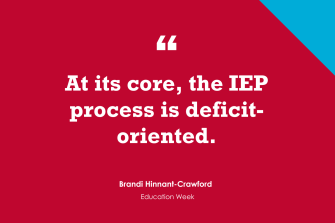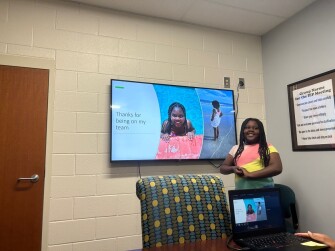Most teachers, and many parents, are well aware of IEPs, or individualized education programs.
Today, an educator and parent shares her experience transforming the typical IEP process and meeting.
Navigating the IEP Meeting
Brandi Hinnant-Crawford is an associate professor of educational leadership at Clemson University and the author of Improvement Science in Education: A Primer. She is the mother of 10-year-old twins—Elizabeth Freedom and Elijah Justice Crawford:
Nausea. Anxiety. Guilt. Despair.
Your child cannot . . .
Your child should be able to . . .
Your child is testing at # grade levels behind . . .
Every spring, I attend an annual review of my daughter’s IEP. I sit around with teachers I adore and trust, administrators I respect, and professionals whose opinions and expertise I value. Yet, my heart races, my stomach churns, my eyes water. I know these well-intended educators are attempting to make space in a place not designed for children like mine. I dread being at this table. Every. Single. Time.
Educators know how to couch feedback. So, IEP meetings often start with all the adults saying positive things about the child. “What a joy she is to be around.” “Her smile is infectious.” “I love to hear her sing.” All of which inflates my spirit before the onslaught of statements telling me the myriad ways my kid is failing. At its core, the IEP process is deficit-oriented, seeking to provide fixes for neurodivergent and physically (dis)abled children.

The Individuals with Disabilities Education Act guarantees children who are differently abled access to a free and appropriate education in the least restrictive environment. One way it guarantees this is through individualized education programs, documents written and revised annually to guide the child’s educational experience. IDEA statute outlines eight components of an IEP in 20 USC § 1414 (d)(1)(b). Paraphrased for brevity, the eight components are:
1. Child’s present performance
2. Measurable annual goals
3. Progress monitoring toward those goals
4. Services provided
5. Explanation of any time a child is not in a mainstream environment
6. Accommodations on assessments
7. Date for beginning services
8. Once age 16, postsecondary plans and transition planning
IDEA is criticized for having an “excessive focus on process over substance” (Bagenstos, 2009, p.122). This is due in part to the Board of Education v. Rowley (1982) decision that stated, “Full participation of concerned parties throughout the development of the IEP . . . demonstrates the legislative conviction that adequate compliance with the procedures prescribed would in most cases assure . . . what Congress wished in the way of substantive content in an IEP” (Yudoff et al., 2002, p. 706).
Full participation is hard when your heartbeat is louder than the people speaking in the room. How can we mitigate the emotional toll in IEP meetings so they do not become a site of trauma and spirit-murdering for children and families but a space of critical hope and prophetic imagination about the possibilities of school?
My child is a 5th grader, and I have been attending IEP meetings since before kindergarten. I have picked up strategies along the way to share with educators and families alike to navigate the inevitably emotional process of IEP meetings.
Lesson One: Never go alone. As a guardian, your nerves are wound tight before you walk in the room. Take someone with you who can help you listen and help you ask questions. Meet with that individual beforehand and share your concerns or priorities; that way, if your emotions inhibit your full participation, the person with you can stand in the gap. Educators, even if you do not perceive the room as intimidating and the content as overwhelming, encourage families to bring a friend.
Lesson Two: Prepare for the meeting (to the extent possible). In 2019, I decided I would never go into an IEP meeting without a plan. I developed a one-page handout that showed my child’s reading level and where the state’s Read to Achieve law wanted her to be. I also changed the language from deficit- to asset-based, naming her strengths and opportunities for growth, and I brought my own strategies to the meeting. Having my own cheat sheet ensured as emotions flared my ideas were shared with everyone.
Educators, it would help immensely if you touched base with families prior to the meeting can help them prepare. Sending progress reports or even prompts to discuss with their child about their experience can be tools to help families feel more prepared. Also, intentionally make space in meetings for families to articulate their priorities before hearing educators’ suggestions; the power dynamics may make people feel as if they need to follow the advice of the experts and they are there to listen more than contribute.
Lesson Three: Full Participation. As IDEA outlines the IEP team, which includes educators and families, 20 USC § 1414 (d)(1)(c)(vii), the team should include “whenever appropriate, the child with the disability.” But when do we deem it is appropriate and how do they participate? I had the fortunate opportunity to sit at the feet of Beverly Jenkins and Heidi Hata from the and listen to their stories of improving IEP outcomes and processes in several districts in California. They aimed to improve the number of students meeting their IEP goals; one catalyst for improvement introduced by the Clovis Unified school district’s special education team was ways to include students in the meeting. After creating a developmental progression for involvement for students with all kinds of (dis)abilities, they also created templates so the student could not only participate but lead the IEP meeting.
As one who believes in stealing good ideas, I borrowed the slide show template and shared it with my daughter the night before her IEP meeting. She filled in the slides down to what pictures she wanted to include. The template asked to name her strengths, hobbies, goals, dis(ability), it’s impact on learning, and how she learns best. The disabilities movement has championed the mantra “Nothing about us without us,” and I am ashamed that for years I had attempted to speak for Elizabeth. Elizabeth had answers for every prompt.
The meeting began with her presentation. She set the tone and shifted the atmosphere. No nausea, no tears, no anxiety. We began with a demonstration of her capabilities, not her deficiencies. Every child may not present, but every child can be present.

Image by Brandi Hinnant-Crawford
It is important to note the strategy employed was developed by educators, special educators, who engage in this work daily. Educators (in collaboration with families and students) possess the ingenuity and the magic to reimagine schooling and disrupt practices that lead to poor outcomes and bad experiences. I do not believe the days of difficult IEP meetings are behind me, but I have multiple strategies I can employ to help me be the best advocate for my child.
Some view IEPs as paperwork, others a policy processes, but it has the potential to be a transformative participatory praxis. For it to be transformative, we must navigate the inevitably emotional process to ensure full participation and co-design of individualized educational programs that capitalize on the assets and insights of the students themselves.

Bagenstos, S. (2009). The judiciary’s now-limited role in special education. In J. Dunn & M. West (Eds.), From Schoolhouse to Court House: The Judiciary’s Role in American Education (pp. 121–141). Brookings Institute Press.
Yudof, M., Kirp, D., Levin, B., & Moran, R. (2002). Educational Policy and the Law (Fourth ed.). Wadsworth Cengage Learning.
Thanks to Brandi for contributing her thoughts!
The new question of the week is:
What advice would you give to parents and teachers about IEP meetings?
Consider contributing a question to be answered in a future post. You can send one to me at lferlazzo@epe.org. When you send it in, let me know if I can use your real name if it’s selected or if you’d prefer remaining anonymous and have a pseudonym in mind.
You can also contact me on Twitter at .
Education Week has published a collection of posts from this blog, along with new material, in an e-book form. It’s titled .
Just a reminder; you can subscribe and receive updates from this blog via (The RSS feed for this blog, and for all Ed Week articles, has been changed by the new redesign—new ones are not yet available). And if you missed any of the highlights from the first 11 years of this blog, you can see a categorized list below.
- It Was Another Busy School Year. What Resonated for You?
- How to Best Address Race and Racism in the Classroom
- 69��ý Just Let Out, But What Are the Best Ways to Begin the Coming Year?
- Classroom Management Starts With Student Engagement
- Teacher Takeaways From the Pandemic: What’s Worked? What Hasn’t?
- The School Year Has Ended. What Are Some Lessons to Close Out Next Year?
- Student Motivation and Social-Emotional Learning Present Challenges. Here’s How to Help
- How to Challenge Normative Gender Culture to Support All 69��ý
- What 69��ý Like (and Don’t Like) About School
- Technology Is the Tool, Not the Teacher
- How to Make Parent Engagement Meaningful
- Teaching Social Studies Isn’t for the Faint of Heart
- Differentiated Instruction Doesn’t Need to Be a Heavy Lift
- How to Help 69��ý Embrace 69��ý. Educators Weigh In
- 10 Strategies for Reaching English-Learners
- 10 Ways to Include Teachers in Important Policy Decisions
- 10 Teacher-Proofed Strategies for Improving Math Instruction
- Give 69��ý a Role in Their Education
- Are There Better Ways Than Standardized Tests to Assess 69��ý? Educators Think So
- How to Meet the Challenges of Teaching Science
- If I’d Only Known. Veteran Teachers Offer Advice for Beginners
- Writing Well Means Rewriting, Rewriting, Rewriting
- Christopher Emdin, Gholdy Muhammad, and More Education Authors Offer Insights to the Field
- How to Build Inclusive Classrooms
- What Science Can Teach Us About Learning
- The Best Ways for Administrators to Demonstrate Leadership
- Listen Up: Give Teachers a Voice in What Happens in Their 69��ý
- 10 Ways to Build a Healthier Classroom
- Educators Weigh In on Implementing the Common Core, Even Now
- What’s the Best Professional-Development Advice? Teachers and 69��ý Have Their Say
- Plenty of Instructional Strategies Are Out There. Here’s What Works Best for Your 69��ý
- How to Avoid Making Mistakes in the Classroom
- Looking for Ways to Organize Your Classroom? Try Out These Tips
- Want Insight Into Schooling? Here’s Advice From Some Top Experts
I am also creating a .






